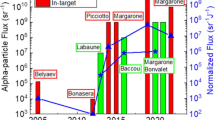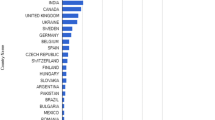Abstract
We report measurements of the fusion reaction rate in the Tokamak Fusion Test Reactor (TFTR) covering a wide range of plasma conditions and injected neutral-beam powers up to 6.3 MW. The fusion neutron production rate in beam-injected plasmas decreases slightly with increasing plasma density ne, even though the energy confinement parameter neτE generally increases with density. The measurements indicate and Fokker-Planck simulations show that with increasing density the source of fusion neutrons evolves from mainly beam-beam and beam-target reactions at very low ne to a combination of beam-target and thermonuclear reactions at high ne. At a given plasma current, the reduction in neutron source strength at higher ne is due to both a decrease in electron temperature and in beam-beam reaction rate. The Fokker-Planck simulations also show that at low ne, plasma rotation can appreciably reduce the beam-target reaction rate for experiments with coinjection only. The variation of neutron source strength with plasma and beam parameters is as expected for beam-dominated regimes. However, the Fokker-Planck simulations systematically overestimate the measured source strength by a factor of 2–3; the source of this discrepancy has not yet been identified.
Similar content being viewed by others
References
J. M. Dawsonet al., Phys. Rev. Lett. 26:1156 (1971).
P. C. Efthimionet al., Phys. Rev. Lett. 52:1492 (1984) (Ohmic heating results). K. M. Younget al..Plasma Phys. 26:11 (1984). M. Murakamiet al., Fusion Technol. 8:657 (1985) (NBI results).
D. L. Jassby,Nucl. Fusion 17:305 (1977).
L. Spitzer Jr.,Physics of Fully Ionized Gases, 2nd ed. (John Wiley & Sons, New York, 1962), p. 134.
J. D. Strachanet al., Nucl. Fusion 21:67 (1981).
H. W. Hendelet al. Proceedings of the Fourth ASTM-Euratom Symposium on Reactor Dosimetry (National Bureau of Standards, Washington, DC, 1982), CONF-820321/V2, p. 94.
E. B. Nieschmidtet al, Rev. Sci. Instr. 56:1084 (1985).
N. Jarmie and R. E. Brown,Nucl. Inst. Methods B10/11:405 (1985).
W. W. Heidbrink, private communication.
L. P. Kuet al., Princeton Plasma Physics Laboratory PPPL-2244 (1985). Note that approximately fifty percent of the neutrons in the source energy group are scattered neutrons (private communication with L. P. Ku).
H. W. Hendel,IEEE Transact. Nucl. Sci. 33:670 (1986).
H. H. Towneret al., Bull. Am. Phys. Soc. 28:1252 (1983).
M. Bitteret al., Phys. Rev. A. 32:3011 (1985).
M. Murakamiet al., Plasma Phys. Control. Fusion 28:1A, 17 (1986).
J. Killeenet al., Modern Plasma Physics (IAEA, Vienna, 1981), p. 395.
A. A. Mirin and D. L. Jassby,IEEE Trans. Plasma Sci. PS-8:503 (1980). R. D. Gillet al., Plasma Phys. Contr. Fusion 26:1B, 341 (1984).
A. H. Futchet al., Plasma Phys. 14:211 (1972). (This fit is due to earlier unpublished work by A. Winslow, 1958, L.L.N.L. Recent work by G. M. Hale, LASL, gives additional credence to Winslow's fit. See Ref. 8.).
G. H. Mileyet al., University of Illinois, C-U Campus, COO-2218-17 (1974). (This fit is due to earlier work by D. H. Duane, see BNWL-1685, 1972.).
P. C. Efthimionet al., presented at The 10th International Conference, London, 1984,Plasma Physics and Controlled Nuclear Fusion Research 1984 (IAEA, Vienna, 1985), Vol. I, p. 29.
G. L. Schmidtet al., Proceedings of 12th European Conference on Controlled Fusion and Plasma Physics (Budapest, Hungary, 1985), Vol. 2, p. 674.
K. Brauet al. Nucl. Fusion 23:1643 (1983).
K. W. Hillet al., Rev. Sci. Instr. 56:1165 (1985).
S. S. Medleyet al., Proceedings of 12th European Conference on Controlled Fusion and Plasma Physics (Budapest, Hungary, 1985), Vol. 1, p. 343.
M. Fois, Equipe TFRProceedings of 13th Conference on Controlled Fusion and Plasma Heating (Schliersee, West Germany, 1986).
R. Kaitaet al., Princeton Plasma Physics PPPL-2321 (1986).
C. D. Boleyet al., Phys. Rev. Lett. 52:534 (1984).
L. R. Grisham, private communication.
H. K. Burrellet al., presented at 10th International Conference, London (1984),Plasma Physics and Controlled Nuclear Fusion Research 1984 (IAEA, Vienna, 1985), Vol. I, p. 131.
D. L. Hilliset al., Bull. Amer. Phys. Soc. 30:1521 (1985). A. Chan and J. D. Strachan,Bull. Am. Phys. Soc. 30:1522 (1985).
Author information
Authors and Affiliations
Additional information
On leave from RCA David Sarnoff Research Center, Princeton, New Jersey 08540.
On assignment from Oak Ridge National Laboratory, Oak Ridge, Tennessee 37831.
On leave from Idaho National Engineering Laboratory, EG&G Idaho, Inc., Idaho Falls, Idaho 83415.
Rights and permissions
About this article
Cite this article
Hendel, H.W., England, A.C., Jassby, D.L. et al. Fusion-neutron production in the TFTR with Deuterium neutral-beam injection. J Fusion Energ 5, 231–244 (1986). https://doi.org/10.1007/BF01050616
Received:
Issue Date:
DOI: https://doi.org/10.1007/BF01050616




